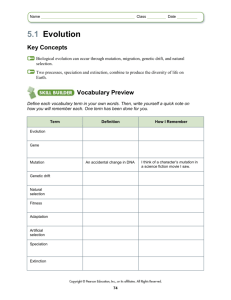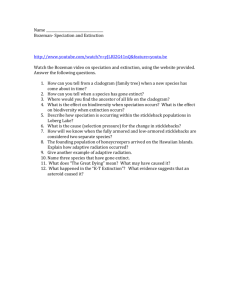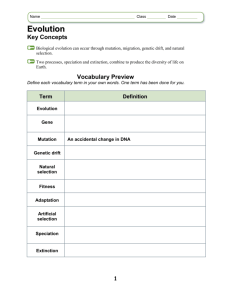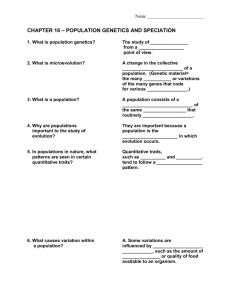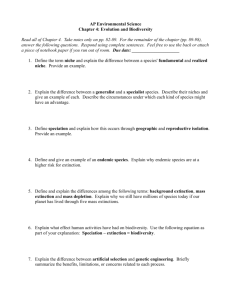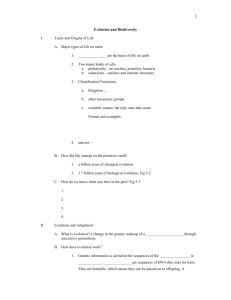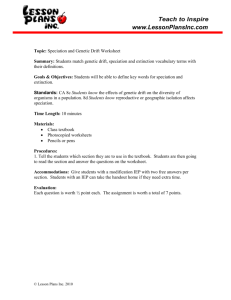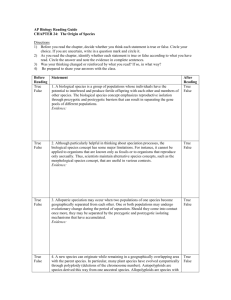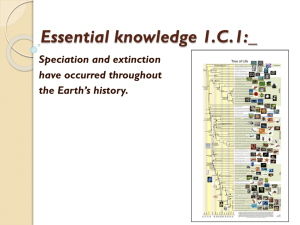The early history of population genetics
advertisement
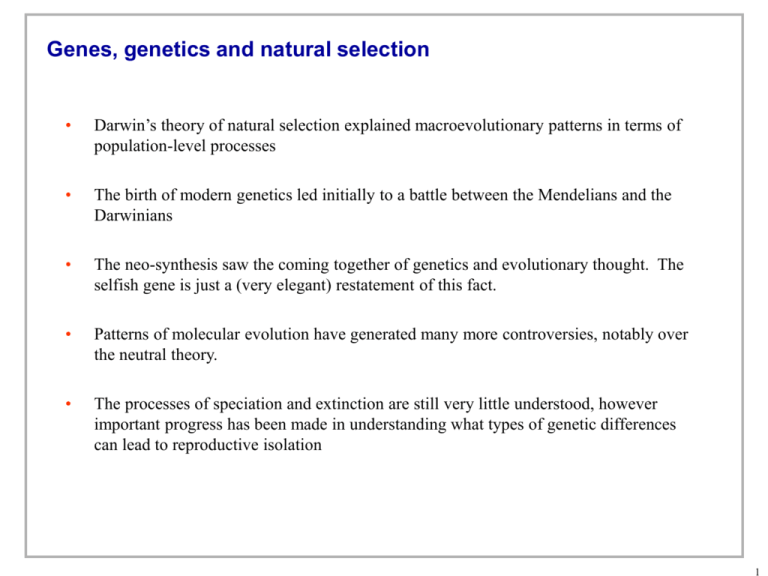
Genes, genetics and natural selection • Darwin’s theory of natural selection explained macroevolutionary patterns in terms of population-level processes • The birth of modern genetics led initially to a battle between the Mendelians and the Darwinians • The neo-synthesis saw the coming together of genetics and evolutionary thought. The selfish gene is just a (very elegant) restatement of this fact. • Patterns of molecular evolution have generated many more controversies, notably over the neutral theory. • The processes of speciation and extinction are still very little understood, however important progress has been made in understanding what types of genetic differences can lead to reproductive isolation 1 What Darwin said Organisms produce too many offspring Heritable differences exist in traits influencing the adaptation of an organism to its environment Organisms that are better adapted have a higher chance of survival 2 Galton’s law of regression to the mean • Characters are correlated between relatives – height, hereditary genius • But over time, deviations from the mean tend to be diluted – Great men have less great sons! • Natural selection cannot produce persistent change 3 Mendel’s peas x x AA x aa Aa x Aa AA/Aa & 3 aa 1 Rediscovered c. 1901 by de Vries, Correns and Tschermak von Seysenegg 4 Mendelians versus biometricians • Mendelians – – – – – • Adherents of Galton’s conclusion that natural selection is ineffective Evolution proceeds in large steps (saltational) Mutations of discrete nature Natural selection cannot work because of regression towards mean Bateson, de Vries Biometricians – – – – Adherents of gradualist, Darwinian view Variation is truly continuous Large mutations happen, but are not very important Pearson, Weldon 5 Nilsson Ehle’s wheat (1909) Genotype AA Aa aa BB Bb bb 6 Morgan and the fly-room (Sturtevant, Muller and Bridges) • • • Discovered crossing-over (cM) Proved chromosomes carried hereditary factors Showed heritability of bristle number in Drosophila 7 Fisher’s results on genetic variation • • First widely read mathematical treatment of selection Three types of quantitative trait – Continuous (weight, height, milk yield) – Meristic (bristle number in Drosophila) – Discrete with continuous liability (disease susceptibility) Frequency Phenotypic variance = s2P Trait value σ P2 σ A2 σ D2 σ I2 σ E2 Phenotypic Additive genetic Dominance Epistatic Environmental Genetic 8 Estimating the genetic component of quantitative traits Offspring value (y) y=a+bx XX X X X σA Cov(x, y) 2 b= = h = 2 Var(x) σP 2 X X X X X X X Mid-parent value (x) m mS Dm h2 (mS - m) Selection response Trait value Trait value 9 The neo-synthesis (1920s-1930s) • Contributions to a coherent Darwinian view of evolution by natural selection from geology, palaentology, natural history, cytology, genetics, and populations genetics • Variation in natural populations – – – – – – – Mimicry in butterflies Industrial melanism in moths Pin and thrum flower forms in Primula Darwin’s finches Sickle-cell anaemia Birth weight Disease All maintained by natural selection +/recurrent mutation 10 The selfish gene • The evolutionary theory of Haldane, Fisher and Wright is a gene-centred view – – considers whether a new mutation will spread through a population NOT what is best for the population • However, natural selection acts on the set of genes it finds in an individual • The correlation of relatedness over evolutionary time will determine whether of nor the fitness interactions between genes are important in shaping evolution – – – Y chromosome genes Green-beard genes and kin recognition Selfish genetic elements (segregation distorters, cytoplasmic male sterility, sex-ratio distorters) 11 Can natural selection explain • Mimicry? The photo shows unpalatable swallowtail model species (left) and palatable mimetic forms of female Papilio memnon (right). At bottom is the Papilio memnon male. This polymorphic, female-limited Batesian mimicry was first described by Alfred Russel Wallace (1865). 12 • Social insects? A Camponotus japonicus ant sharing honey with another ant Mother Sister Daughter Father brother son Niece or Nephew female 0.5 0.75 0.5 0.5 0.25 0.5 0.375 male 1 0.5 1 0 0.5 0 0.25 Haplodiploid Relatedness in haplodiploid insects 13 Kin selection • Work by Hamilton, Price and others showed the importance of interactions between relatives in explaining biological patterns • JBS Haldane – “I would be willing to lay down my life for 2 brothers or 8 cousins.” rb c 0 Relatedness Cost to actor Benefit to receiver of action 14 • Sex-related characteristics? Stalk-eyed fly Irish elk 15 Two or three theories of sexual selection • Fisherian runaway process – – – – • Good-genes – – • Females have an asymmetric preference for a male trait which varies in the population Males with the favoured trait are more successful in mating irrespective of whether they are better adapted to their environment The population will shift towards the new trait Requires covariance between trait and female preference Sexually selected traits are indicators of good genes (Hamilton and Zuk) E.g. the wattle on a rooster indicates parasite load Costly traits and the handicap principle – – Costly traits can evolve as honest signals of quality as females will always benefit from being choosy (Doesn’t have to be a good genes argument) 16 Species-level selection? (Stanley 1975) • Higher-level selection leading to long-term changes in clade morphology can occur if… – – – • Speciation rates are correlated with parameters of life-history/ecology OR extinction is selective AND rates of speciation and extinction are uncoupled from what natural selection favours within populations Evidence? – – – Major extinctions were highly selective Planktotrophic gastropod molluscs have lower extinction rates than those with direct development BUT the fossil record shows a relative increase in the number with direct development (higher speciation rates?) Completely asexual lineages (e.g. some rotifers, fish, lizards) usually at tips of trees, suggesting they are short-lived 17 Evolution at the molecular level: The molecular clock • The number of differences between genes at the molecular level correlates with the time separating the species (Zuckerkandl and Pauling 1962) • The rate of substitution is constant over time • Sarich and Wilson (1967) used the molecular clock to estimate the human-chimp split as 5MY – previously thought to be 14MY Doolittle et al. (1996) 18 Does natural selection explain molecular evolution? Kimura (1968); King and Jukes (1969) • Constancy of rate of molecular evolution (the molecular clock) • More important regions of proteins evolve at a slower rate than less important domains • High levels of protein polymorphism • High rates of molecular evolution (about 1.5x10-9 changes per amino acid per year – even in living fossils!) 19 Kimura’s neutral theory • • The majority of changes in proteins and at the level DNA which are fixed between species, or segregate within species, are of no selective importance The rate of substitution is equal to the rate of neutral mutation k f neutral μ • The level of polymorphism in a population is a function of the effective population size and the neutral mutation rate π 4 Ne μ • Polymorphisms are transient rather than balanced Frequency NOW Balanced NOW Transient Time 20 Detecting natural selection at the gene level • Bursts of amino acid substitution in lineages • Amino acid changes concentrated at sites within proteins – HLA • Specific footprints in patterns of genetic variation – Genetic hitchhiking 21 Speciation and extinction • How do new species arise? – Gradual accumulation of differences between geographically separated populations exposed to different selective pressures - allopatric – Rapid event associated with change in lifestyle (e.g. host-plant preference, mating song, chromosome number, hybridisation) – sympatric • How can we study the process of speciation? – Hybrid zones – Genetic footprints – Analysis of reproductive isolation • Why do species go extinct? – Major extinctions in evolutionary history – Anthropogenic extinction 22 The biological species concept • A species is a population whose members are able to interbreed freely under natural conditions – Many species can hybridise when brought together (e.g. ligers & tions) – Where do primarily asexual species fit in? (e.g. bacteria) – Many species complexes (particularly plants, e.g. elms) • Phylogenetic - Individuals within a species are more closely related to each other than to any other organisms – Gene trees versus species trees Congruent Incongruent E.g. Only 52% human genes closest to chimps. Rest are (H,(C,G)) or ((H,G),C) Satta et al. (2000) 23 Allopatric speciation • Vicariance events – Mountain, river, marsh, forest arises and separates populations – E.g. numerous species boundaries at Pyrenees • Peripatric – Populations at periphery of species range get separated and diverge – May be associated with ‘founder’ events – E.g. island species • Centrifugal – Contraction of species range leads to differentiation among refugial populations, which overwhelm peripheral populations (like Wright’s shifting balance) 24 Islands – extreme allopatry • New and unusual species often form on islands associated with reduced competition and broadening of potential ecological niches Gigantism Flightlessness Occupation of Unusual niches 25 Vertebrate species richness Geographical patterns in species richness Energy (evapotranspiration) Species richness in the US 26 Sympatric speciation • Speciation over over-lapping populations due to change in – Host-plant preference (Rhagoletis) – Local adaptation in association with the evolution of pre-mating isolation (Chiclid fishes in lake Victoria) – Changes in courtship song (crickets) • Maybe driven by sexual selection? – Birds of paradise – Leipdoptera 27 Studying speciation – ring species Greenish warblers in Asia The two overlapping Siberian forms have different song patterns Elsewhere, the pattern varies more or less continuously with an EW axis of increasing complexity Irwin (2000) 28 Studying speciation - hybrid zones Pyrenean hybrid zone in Corthippus parallelus 29 The genetics of speciation • Gradients in allele frequency across hybrid zones indicate that some genes can cross the genetic barrier • Variation in gradient indicates some genes are linked to factors generating hybrid incompatibility • Studies on Drosophila show some variation is shared between species while others are only in one 30 Haldane’s rule • In crosses between two species, if one sex is missing or sterile it is the heterogametic (XY) sex X Y Mammals Bird Butterflies Male Female Female X X Female Male Male • Interactions between genes on the X and autosomes are ‘imbalanced in the heterogametic hybrid • ‘Speciation genes’ can be mapped in Drosophila between related species – Only one putative speciation gene has been found (but it is very interesting) 31 Chromosomal speciation • New plant species can form when species hybridise – E.g. Wheat, Helianthus petiolaris and H. annuus x Years of natural selection Natural experiment Similar set of chromosomal segments retained Artifical selection x For viability Lab experiment 32 Taxonomic survivorship curves 33 Van Valen’s Red Queen hypothesis • Deterioration in the environment of a species caused by continual adaptation of competitors leads to a constant per unit time risk of extinction, so a geometric distribution of species survivorship times • Based around idea that ecology is a zero-sum game 34 The Permian extinction • • • • Largest extinction in the history of life – 251 MY ago 80% marine species went extinct in 1MY 9 orders of insect and therapsid reptiles lost Associated with massive volcanic activity, large increase in CO2 and global warming 35 The K/T mass extinction • • • 65 MY ago 15% marine invertebrate families and 45% genera lost Extinction of the dinosaurs 36 Evidence for the asteroid theory (Alvarez et al. 1980) • Iridium spike at K/T boundary – High concentrations in extraterrestrial objects • • • Soot in same layer Shocked quartz crystals Putative crater off Yucatan peninsula • BUT all can also be produced by volcanoes? 37 Historical anthropogenic extinctions • Wave of extinction of large animals in Australia around time of appearance of first humans (c. 50,000 YA) – BUT Worldwide, there is no evidence of Indigenous hunter-gatherers hunting nor over-killing megafauna. The largest regularly hunted animal was bison in North America and Eurasia, yet it survived for about 10,000 years until the early 20th century. For social, religious and economic reasons, Indigenous hunters harvested game in a sustainable manner. http://www.amonline.net.au/factsheets/megafauna.htm • However, in the last 300 years there have been 27 extinctions of large mammals on continents and 55 on islands (including Australia) 38 Factors endangering species • • • • • Habitat loss Exotics Pollution Over-harvesting14% Disease 88% 46% 20% 2% (43 % UK plant species exotics) (Wilcove et al 1998) Number of species in group Vertebrates Mammals Birds Reptiles Amphibians Fishes Subtotal Number of Number of Number of % of total in % of total threatened threatened threatened group assessed species in species in species in threatened in threatened in 2002 2002* 4,763 9,946 7,970 4,950 1996 1,096 1,107 253 124 2000 1,130 1,183 296 146 2002 1,137 1,192 293 157 25,000 52,629 734 3,314 752 3,507 742 3,521 24% 12% 4% 3% 24% 12% 25% 21% 3% 7% 30% 18% IUCN Red list 2002 39
